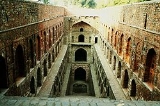
Agrasen ki Baoli
Encyclopedia

Connaught Place, New Delhi
Connaught Place Connaught Place Connaught Place (Hindi: कनॉट प्लेस, (officially Rajiv Chowk) is one of the largest financial, commercial and business centers in Delhi. It is often abbreviated as CP and houses the headquarters of several Indian firms. Its surroundings occupy a place of pride...
, a short walk from Jantar Mantar in New Delhi
New Delhi
New Delhi is the capital city of India. It serves as the centre of the Government of India and the Government of the National Capital Territory of Delhi. New Delhi is situated within the metropolis of Delhi. It is one of the nine districts of Delhi Union Territory. The total area of the city is...
, India. Although there are no known historical records to prove who built Agrasen ki Baoli, it is believed that it was originally built by the legendary king Agrasen
Agrasen
Maharaja Agrasena was a legendary Indian king of Agroha, a city of traders, from whom the Agrawal and Agrahari clans trace their origin...
during the Mahabharat epic era and rebuilt in the 14th century by the Agrawal
Agrawal
Agrawal or Agarwal is a large and influential community in India. Agrawals are Kshatriya by birth of the Solar Dynasty but after the adoption of Vanika dharma by king Agrasena, Agrawals started dealing in business...
community which traces its origin to Maharaja Agrasen.
Baoli or bawdi
Stepwell
Stepwells, also called bawdi or baoli , or vaav are wells or ponds in which the water can be reached by descending a set of steps. They may be covered and protected, and are often of architectural significance...
, also referred to as baori or bauri, is a Hindi
Hindi
Standard Hindi, or more precisely Modern Standard Hindi, also known as Manak Hindi , High Hindi, Nagari Hindi, and Literary Hindi, is a standardized and sanskritized register of the Hindustani language derived from the Khariboli dialect of Delhi...
word (from Sanskrit
Sanskrit
Sanskrit , is a historical Indo-Aryan language and the primary liturgical language of Hinduism, Jainism and Buddhism.Buddhism: besides Pali, see Buddhist Hybrid Sanskrit Today, it is listed as one of the 22 scheduled languages of India and is an official language of the state of Uttarakhand...
wapi or vapi, vapika). In Rajasthan
Rajasthan
Rājasthān the land of Rajasthanis, , is the largest state of the Republic of India by area. It is located in the northwest of India. It encompasses most of the area of the large, inhospitable Great Indian Desert , which has an edge paralleling the Sutlej-Indus river valley along its border with...
and Gujarat the words for step well include baoli, bavadi, vav, vavdi and vavadi. Water temples and temple step wells were built in ancient India and the earliest forms of step well and reservoir were also built in India in places like Dholavira
Dholavira
Dholavira is an archaeological site in Khadirbet in Bhachau Taluka of Kachchh district of Gujarat state in western India, which has taken its name from a modern village 1 km south of it. The site of Dholavira, locally known as Kotada timba contains ruins of an ancient Harappan city...
as far back as the Indus Valley Civilisation.
Architecture
It is among a few of its kind in DelhiDelhi
Delhi , officially National Capital Territory of Delhi , is the largest metropolis by area and the second-largest by population in India, next to Mumbai. It is the eighth largest metropolis in the world by population with 16,753,265 inhabitants in the Territory at the 2011 Census...
. Some parts of the well, with 103 steps, are permanently immersed in water. The visible parts of this historical step well consist of three levels. Each level is lined with arched niches on both sides. From an architectural perspective this step well was probably rebuilt
during the Tughlaq period. However, the oldest existing Baoli in Delhi, the Anangtal Baoli located in Mehrauli
Mehrauli
Mehrauli is a neighbourhood in the South West district of Delhi in India. It represents a constituency in the legislative assembly of Delhi. The area is located close to Gurgaon.-History:...
which was also known as Yoginipura
Yogmaya Temple
Yogmaya Temple also known as Jogmaya temple, is an ancient Hindu temple dedicated to Goddess Yogmaya, the sister of Krishna, and situated in Mehrauli, New Delhi, close to the Qutb complex. It is widely believed to be one of the five surviving temples from the Mahabharata period in Delhi.Yogmaya or...
, was built in the 10th century by the Rajput
Rajput
A Rajput is a member of one of the patrilineal clans of western, central, northern India and in some parts of Pakistan. Rajputs are descendants of one of the major ruling warrior classes in the Indian subcontinent, particularly North India...
King Anang Pal II of Tomar Dynasty
Tomar Rajputs
The Tomara dynasty are a Hindu clan, who claim descent from the Puruvanshi lineage of Indraprashtha of Mahabharata times.It includes Rajputs, Gurjars and Jats of northern India.-History:...
. Anang Tal literally means reservoir provided by Anang Pal of the House of Tomar.
Regarding the name Agrasen Ki Baoli it should be stated that in 1132 AD an Agrawal poet named Vibudh Shridhar
Vibudh Shridhar
Vibudh Shridhar or Vibudha Shridhara was an accomplished Apabhramsha writer and poet in North India. He is the first known Agrawal author...
mentions, in his work Pasanahacariu, a wealthy and influential Agrawal merchant of Dhilli named Nattal Sahu
Nattal Sahu
Nattal Sahu of Yoginipur is the earliest known Agrawal merchant-prince, who lived during the reign Tomara king, Anangapal. His life's account is described in Apabhramsha text Pasanaha Cariu of poet Vibudh Shridhar, written in Vikrama Samvat 1189 .Nattal's father was Sahu Joja...
who was also a minister in the court of King Anang Pal III. Rebuilding the old Baoli would have been
within the means of a wealthy Agrawal community.

